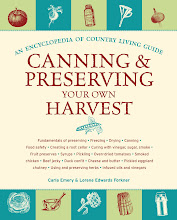It's
been a sunny June in the Northwest, and beets are popping up everywhere
— on restaurant menus, at farmers markets, and hopefully in your
garden! Carla Emery shares tips on canning and preparing, and a few
recipes for enjoying your beets.
- Precooking by Baking. Cut off tops and roots. You can put beets of any size together in the oven (conventional or microwave). They're all cooked when the biggest one is done. Then pour cold water over the hot, roasted beets, and you'll be able to slip off their skins. Dump the water.
- Precooking by Boiling. Remove the entire beet top except for the closest 1-2 inches of stem. Leave the roots on; that keeps them from "bleeding" (losing nutrients). Sort beets according to size, and boil similar sizes together so they'll get done at about the same time. When fork-tender (in about 30 minutes), move them into cold water. Slip off skins, stems, and roots.
- Cutting Up. You cut up beets to improve and even out heat penetration in your jar. If baby beets are smaller than 2 inches wide, they can be left whole. If they're larger, cut them into 1⁄2 - inch cubes. Or slice 1⁄2 inch thick, and then quarter the slices.
- Packing and Processing. Pack beets into hot jars. Cover with boiling water, leaving 1⁄2 inch headspace. Optional: Add 1⁄2 t. salt/pt., 1 t. salt/qt.; add 1 T. vinegar/pt., 2 T./qt. to preserve color. Process in a pressure canner only: pints for 30 minutes, quarts for 35 minutes. If using a weighted-gauge canner, set at 10 lb. pressure at 0-1,000 feet above sea level; set at 15 lb. at higher altitudes. If using a dial-gauge canner, set at 11 lb. pressure at 0-2,000 feet above sea level; 12 lb. at 2,001-4,000 feet; 13 lb. at 4,001-6,000 feet; 14 lb. at 6,001-8,000 feet; or 15 lb. above 8,000 feet.
Pickled Beets: Start by carefully scrubbing 7 lb. of beets (2 to 2 1⁄2 inches in diameter) to remove all dirt. Now
trim off beet tops, leaving on 1 inch of stem and roots to prevent nutrient loss. Wash well. Sort by size. Cover size-grouped
beets with boiling water and cook until tender (25 to 30 minutes). Drain and discard liquid. Cool beets. Trim off roots
and stems and slip off skins. Slice into 1⁄4 - inch slices. Peel and thinly slice.
Combine 4 c. vinegar (5 percent), 1 1⁄2 t. canning or
pickling salt, 2 c. sugar, and 2 c. water. Put 2 cinnamon sticks and 12 whole cloves in a cheesecloth bag and add to vinegar mixture. Bring to a boil.
Add beets and 4 to 6 onions (2 to 2 1⁄2 inches in diameter). Simmer 5 minutes. Remove spice bag. Fill pint or quart jars with hot beets and onions, leaving 1⁄2 inch headspace.
Adjust lids. Process either pints or quarts in boiling-water canner. At up to 1,000 feet above sea level, process 30 minutes; at 1,001–3,000 feet, 35 minutes; 3,001–6,000 feet,
40 minutes; and above 6,000 feet, 45 minutes.
Pickled Whole Baby Beets Follow above directions, but use beets that are 1 to 1 1⁄2 inches in diameter. Pack whole; don’t slice. You can leave out the onions.
Preparing
Eating Baby Beets. Thinning beets has a really good side.
You can eat the thinnings. Eat the tops like greens. If they're big enough to
have roots of any development, eat both tops and roots together. I boil top
greens and bottom root with bacon and add butter at serving time. Delicious! I
like beets best of all at the "baby" stage - that's around 1 1⁄2 to 2
inches in diameter, about the size of a radish. Baby beets are also nice for
eating, freezing, canning, or pickling.
Precooking Beets to Eat Fresh. Cut off tops. You may or
may not leave a stub (leaving it prevents nutrient loss). Cover with boiling
water, and boil until the beets are slightly soft to the touch. Another way to
precook beets is to bake them in the oven. The bigger they are, the longer it
takes. Drain and slip off the skins; no peeling is necessary. Cut off any remaining
root tail and the stalk stub.
Recipes
Quick Beet Soup: Combine 2 c. milk, 1⁄2 c. beet juice, and seasonings.
Cold Beet Salad: Cook 1 lb. beets until tender. Cool, peel, and slice thinly. Combine 4 T. vinegar, 4 T. water, 1⁄2 t. sugar, 2 1⁄2 t. caraway seeds, 1 chopped small onion, 1 t. ground cloves, 1 bay leaf, salt, pepper, and 4 T. oil. Pour over
beets and let marinate several hours before serving.
Orange/Beet
Juice: From Ruth of Bonaire: "Make fresh orange juice - enough to fill the blender two-thirds full.
Then add 1⁄4 c. peeled, cubed raw beet. Blend and then pour through a strainer, a bit at a time, mashing pulp with a spoon to extract the maximum amount of juice. You can eat the pulp-it's sweet! This juice looks and tastes like red Kool-Aid!"
NOTE: Fresh garden beets have more color than most digestive systems can absorb, so your resulting bowel movement may appear to have “blood” in it. That’s just beet color. Eating beets is absolutely not harmful — on the contrary, beets are very nourishing. And they’re not harsh to digest, only startling to view in that manner.
NOTE: Fresh garden beets have more color than most digestive systems can absorb, so your resulting bowel movement may appear to have “blood” in it. That’s just beet color. Eating beets is absolutely not harmful — on the contrary, beets are very nourishing. And they’re not harsh to digest, only startling to view in that manner.








No comments:
Post a Comment